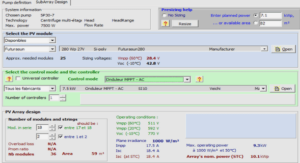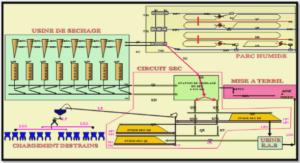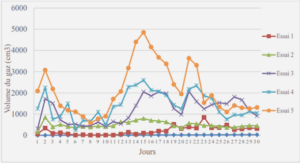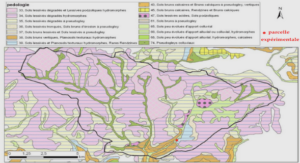Initial conditions of fresh corn forage
Background ofthe study
Silage is the feedstuff produced by the fermentation of green forages and crops, based on lactic acid bacteria (LAB) fermentation under anaerobie conditions (Ashbell, et al., 2002; Rossi and Dellaglio, 2007; Weinberg, et al., 2001). Silage can be made from a large variety of forages and crops, such as grasses, corn (Zea mays), sorghum (Sorghum bicolor), legumes, whole-crop cereals and small grains. It is usually stored in a silo, i.e., in a bunker, a tower, a covered heap or in wrapped hales, to allow the product to ferment.
Compared with haymak:ing, silage production is less dependent on weather and thus better adapted to harvesting crops at the optimum stage of maturity in order to ensure optimal nutritional value (Allen, et al., 2003). In recent years, silage production has gained popularity in many countries. For instance, in European countries such as the Netherlands, Germany and Denmark, more than 90% of the locally produced forages are stored as silage. Even in countries with generally good weather conditions for haymak:ing, such as France and Italy, about half of the forages are ensiled (Te Giffel, et al., 2002). In North America, silage has formed a major part of the feed ration of cattle and sheep (Wilkinson, et al., 2003).
Ensiling is a process of complex microbial and enzymatic activities (Weinberg, et al., 2001). Many pre- and post-harvest factors affect it, including forage/crop biochemical characteristics (e.g., dry matter content (DM), buffering capacity (BC), water soluble carbohydrate (WSC) concentration), plant management (e.g., manure and fertilizer application, cutting time, cultivars, maturity), harvesting techniques, weather conditions during harvest period (e.g., rainfall, frost, warm temperature), harvest and silo management ( e.g., mowing, chopping, wilting, filling or delayed sealing), and application of biological or biochemical additives (Donald, et al., 1993; Fenlon, 1986; Filya, et al., 2006; Fraser, et al., 200 1; Fychan, et al., 2002; Haigh and Parker, 1985; Hassanat, et al., 2006; Hassanat, et al., 2007; ~nda, et al., 1985; ~rsh, 1979; Muck, 1990; Nishino, et al., 2004; Pauly, et al., 1999; Pedroso, et al., 2005; Ranjit and Kung Jr, 2000; Xing, et al., 2009).
Among all of the above factors, temperature has long been considered a maJor factor affecting silage fermentation (McDonald, et al., 1966; Muck, et al., 2003). Generally speaking, a moderate temperature between 20 and 30 oc is preferred for silage fermentation (Kim and Adesogan, 2006; McDonald, et al., 1966; Weinberg, et al., 1998; 2001). Probably for this reason, the majority of ensiling experiments in the literature were conducted within this temperature range. Additionally, the impacts of high temperature (> 37 °C) have been well studied due to the detrimental effects on forage preservation (Garcia, et al., 1989; Goering, et al., 1973; Kim and Adesogan, 2006; McDonald, et al. , 1966; Weinberg, et al., 1998; 2001). However, the effects of cool temperature(< 20 °C) on silage fermentation have been much less studied. However, in cold climates, cool temperatures can hinder silage fermentation, usually resulting in less intensively fermented silage. In practice, these silages are often found to be associated with high pH and low acid production (Kung, 20 lOb), as well as high residual WSC and yeast counts which make silages more vulnerable to aerobic deterioration during the feed-out period (Ward and de Ondarza, 2008). Moreover, in all the above studies, the evaluation often has been performed only after moderately short lengths of storage (1 to 82 days). There are no long-term storage studies on the effects of temperature on silage fermentation even though silages may remain stored for longer periods of time on manyfarms.
Whole-plant corn silage is a popular forage for ruminant animais because of its relatively consistent quality, its high yields and energy content, and its good digestibility. It is one of the most important forages for ruminants in climates where corn can be grown, particularly in Central Europe and North America. In the last decade, cultivation of this crop further north has become possible following the development of hybrids adaptable to colder regions. In Eastern Canada, corn silages are made in autumn when daily mean temperatures are between 0 and 10 °C. Part of the ensiled corn will be stored and consumed during the following winter and spring season ( < 10 °C). The low temperature could impact greatly the ensiling process as well as affect the storage ofwhole-plant corn silage.
Whole-plant corn silage
Corn originates from Mesoamerica and was domesticated about 7,000 years ago. When the frrst European explorers came to the New W orld, they found corn growing throughout the Americas. Spanish and Portuguese explorers later brought corn back to Europe. Thereafter, corn was introduced throughout the world. Corn can now be found across the world, and it is an essential resource for ensiling to feed ruminant livestock, especially in the Mediterranean region and North America (Wilkinson and Toivonen, 2003). In the United States, corn is planted mainly in the Corn Belt Region (Illinois, Indiana, Iowa, Nebraska, and Minnesota), and it has been the main crop harvested for silage for decades. For instance, in 2000 about 2.46 million ha of corn were harvested for silage, compared with grass (0.39 million ha), legumes (1.32 million ha) and whole-crop cereals (0.11 million ha) (Wilkinson and Toivonen, 2003). According to the latest survey by U.S. Department of Agriculture National Agricultural Statistics Service (NASS), the area planted with corn in the United States was estimated at 39.32 million ha in 2012, and about 2.99 million ha of corn was harvested for silage, an increase of24.31% from the 2011 census (USDANASS, 2013).
In Canada, corn constitutes the third largest crop (after wheat and barley) and is the most important one in Eastern Canada. It is grown primarily in Ontario and Québec, accounting for more than 90% of Canadian corn. In Eastern Canada, more than 200,000 ha of corn (out of 1,200,000) are harvested as whole-plant corn silage every year (OCPA, 2010). Corn is planted from May to June, and it is harvested mainly from late September to early November when daily mean temperatures are between 0 and 10 °C. Ensiled corn then will be stored and consumed during the winter and spring at even cooler temperature ( < 10 °C) (EnvironmentCanada, 2008). Similarly, many other countries or regions with cool climates, such as the northern USA, northeastern China, Japan, and Korea, are also confronted with low temperatures at harvest as well as during the storage period of whole plant corn silage (USDA).
EFFECT OF TEMPERATURES (5 ac to 25 oq ON EPIPHYTie LACTIC ACID BACTERIA POPULATIONS DURING THE ENSILING PROCESS OF WH OLE-PLANT CORNSILAGE
Silage is a very important source of forage for ruminant animais, in particular in areas where animais need to be wintered for long periods of time. It is produced by the anaerobie fermentation of wet forages and other crops. Lactic acid bacteria (LAB), which convert water soluble carbohydrates (WSC) into lactic acid and other organic acids, are the main organisms responsible for silage fermentation. As a consequence of their activity, pH is reduced and the activity of spoilage microbes is inhibited, allowing the conservation of forage nutrients (McDonald, et al., 1991). Epiphytie LAB species, particularly those which dominate the ensiling process, together with other microflora, often dictate the course of fermentation and, accordingly, determine silage quality (Cai, et al., 1998; Lin, et al., 1992b).
Temperature is a major factor affecting ensilage. In the literature, the majority of ensiling experiments were conducted at a moderate temperature between 20 and 30 oc (Kim and Adesogan, 2006; McDonald, et al., 1966; Weinberg, et al., 1998; 2001). Additionally, the impacts of high temperatures (> 37 °C) have been well studied due to their well-known detrimental effects on forage preservation, e.g., resulting in poor quality silage and low aerobic stability (Kim and Adesogan, 2006; Weinberg, et al., 1998; 2001), inducing clostridial fermentation (McDonald, et al. , 1966), heat damage (Garcia, et al., 1989; Goering, et al., 1973), etc. However, the effects of low temperatures (< 20 oq on silage fermentation have been much less studied. But, in cold climates, such as Canada’s, low temperature may be an important factor affecting silage fermentation.
Whole-plant corn silage is one of the most important forages for ruminants in Central Europe and North America. Several studies have investigated the diversity of epiphytie LAB during corn ensiling process (Brusetti, et al., 2006; Lin, et al., 1992b; Parvin, et al., 2010; Stevenson, et al., 2006). However, all thes e studies were conducted at constant temperatures set between 20 and 30 °C. These studies did not consider temperature as a factor which could affect the epiphytie LAB population diversity, and none of them examined the epiphytie LAB population at a temperature below 20 oc (Brusetti, et al., 2006; Lin, et al., 1992b; Parvin, et al. , 2010; Stevenson, et al., 2006). However, low temperature not only could reduce fermentation efficiency by lowering the growth rate and enzymatic activity of microorganisms (Atlas, 1995; Frazier and Westhoff, 1978), but it also may change the composition ofLAB flora in different ecosystems, by selecting certain species adapted to low growth temperatures. For instance, Hagi et al. (2004) reported that the changes in water temperature ( 4 oc to above 20 oq resulted in the seasonal changes in LAB composition in the intestinal tract of freshwater fish. Olstorpe et al. (2008) found that the population diversity ofLAB in a fermented pig feed differed at different low temperatures (10, 15 and 20 °C). Unfortunately, to date, no relevant research studies were conducted on silages.
Silage analysis
The pH was measured with a pH meter (Accumet® AB15, Fisher Scientific, Canada), where duplicate samples (10.0 g) of silage were macerated in 100 mL distilled water for 60 min at 200 rpm. Dry matter (DM) content of fresh corn forage (day 0) was determined by ovendrying for 72 h at 50 ± 2 °C. WSC content in fresh corn forage and fmal corn silage were measured on a water extract (100 mg : 2mL distilled water) using the phenol sulphuric acid colorimetrie method according to Dubois et al. (1956).
Diversity analysis ofLAB
Isolation and identification of epiphytie LAB strains used as external reference strains forDGGE
One extra silo of each temperature treatment (5, 10, 15, 20 or 25 oq was taken out for LAB isolation after 14 days of fermentation. Each silage sample (20.0 g) was homogenized with 180 mL of peptone water [0.2% Bacto peptone (w/v) with 0.01% Tween 80 (w/v)], and seriai dilutions were prepared with the same peptone water. A MRS medium (Difco, USA) was used and the Petri dishes were incubated at 30 oc for 3 days. Approximately 20 colonies were randomly picked up from each temperature treatment. All purified isolates were characterizedµ by their Gram reaction, catalase activity and cell morphology. In order to design the molecular ladder that would be used for the DGGE, total DNA of LAB isola tes was extracted using a hexadecyltrimethylammonium bromide (CT AB) method (Griffiths, et al. , 2004). The 16S rRNA gene of LAB strains was screened and grouped by PCR-DGGE based on the mobility differences of their responding bands, where a primer set ofL1GC/HAD1 was used as described below. Representatives (1 to 7 strains) of each group having the same migration distance in the DGGE gel were selected. Their DNA was then amplified using a universal eubacterial primer set consisting of pA (5′-AGA GTT TGA TCC TGG CTC AG-3′) and pH (5′-AAG GAG GTG ATC CAG CCG CA-3′), which can amplify a contiguous sequence of a nearly complete 16S rRNA gene spanning 1.5 kb (Edwars, et al. , 1989). PCR was carried out in a volume of 25 r.tL containing 1 ~ ofDNA template (50 ng), 1 X standard Taq reaction buffer, 200 !J.M of each deoxynucleotide, 0.2 !J.M of each primer and 0.025 U ~-1 of Taq DNA polymerase (Taq PCR Kit, New England BioLabs, Canada). PCR cycles comprised an initial DNA denaturation at 95 oc for 4 min, 30 cycles of denaturation at 95 oc for 30 s, annealing at 50 oc for 1 min, extension at 68 °C for 1 min, and a fmal elongation step at 68 oc for 5 min. Finally, sequence analysis was conducted with a BigDye® Terminator v3.1 Cycle Sequencing Kit on the genetic analyzer 3130XL (Applied Biosystems, Poster City, USA) at the Plate-forme d’Analyses Biomoléculaires (Université Laval, Canada). PCR amplicons were sequenced in both directions and nucleotide sequences were aligned using software BioEdit version 7.1.3.0. DNA sequence similarity searches were run via BLASTn against the GenBank database of the United States National Center for Biotechnology Information (NCBI). The sequences generated by this study were deposited in GenBank (accession numbers: KC753453 to KC753463).
Diversity analysis of LAB
Diversity analysis of LAB was conducted using PCR-DGGE fmgerprinting. Total DNA was extracted from silages using the PowerFoodTM Microbial DNA Isolation Kit (MoBio Laboratories, Carlsbad, USA). Primers L1 (5′-CAG CAG TAG GGA ATC TTC C-3′) (Meroth, et al., 2003) andHAD2 (5′-GTA TTA CCG CGG CTG CTG GCA-3′) (Tannock, et al., 1999), specifie to Lactobacillus-group including genus Lactobacillus, Weissella, Pediococcus and Leuconostoc, were used to amplify a 185-bp fragment of the V3 region of the 16S rRNA genes. A 40-bp GC clamp (5′-CGC CCG GGG CGC GCC CCG GGC GGC CCG GGG GCA CCG GGG G-3′) was attached to the 5′ end of L1 for DGGE analysis (Walter, et al., 2001). PCR was performed according to Meroth et al. (2003) using same Taq PCR Kit. PCR reactions (25 11L) contained 1 ~ of DNA template (50 ng), 1 X standard Taq reaction buffer, 200 ~of each deoxynucleotide, 0.5 ~of each primer and 0.05 U 1 of Taq DNA polymerase. PCR cycles comprised an initial DNA denaturation at 95 oc for 2 min, 30 cycles of denaturation at 94 oc for 30 s, annealing at 66 oc for 30 s, extension at 68 oc for 1 min, and a fmal elongation step at 68 oc for 7 min. DGGE was carried out using a DCodeTM Universal Mutation Detection System (Bio-Rad Laboratories, Hercules, USA) according to Kebli et al. (2011) with a modification of the range of denaturing gradient. PCR products (10 IlL) were applied on 8% polyacrylamide gels (acrylamide: bis-acrylamide, 37.5:1) with a linear denaturing gradient range of 41% to 50% in lX T AE electrophoresis buffer. Electrophoresis was performed at 75 V and 60 oc for 16 h. Then the gels were stained with SYBR Gold (Invitrogen, Carlsbad, USA) and visualized under UV illumination using a Molecular Imager® ChemiDoc™ XRS System (Bio-Rad Laboratories, Hercules, USA). In addition, PCR products of nine LAB strains previously isolated from the same silages were combined and served as an external reference pattern to which all gels were aligned. DGGE profiles were analyzed using GelCompar II version 6. 5 (Applied Maths, Sint-Martens-Latem, Belgium). Band matching analysis was performed by excluding rare bands and by assigning multiple bands deriving from same LAB species into single band class. One matrix of band-relative intensity and one of band presence/absence were obtained for further diversity analyses. The relative intensity of each band was calculated by dividing the intensity of the band by the sum of the intensity of all the bands within the lane.
GENERAL CONCLUSION
Whole-plant corn silage is a very important feed for ruminant animais. In the last decade, the cultivation of corn has expanded further north. Thus low temperature becomes a potential factor that may affect silage production. In Eastern Canada, whole-plant corn is usually harvested for silage from late September to early November when daily mean temperatures are between 0 and 10 °C. Ensiled corn will then be stored and consumed during the following winter and spring. Other countries or regions where cool temperatures prevail during ensiling might encounter similar issues. Thus, the purpose of this thesis was to study the effects of cool temperature on the fermentation and storage of who le-plant corn silage.
|
Table des matières
CHAPTER I GENERAL INTRODUCTION
1.1 Background of the study
1.2 \\Thole-plant corn silage
1.3 The ensiling process
1.4 Lactic acid bacteria associated with silage
1.5 Silage temperature
1.6 Temperature and lactic acid bacteria in corn silage
1.7 Temperature and silage fermentation
1. 8 Molecular diversity techniques in silage microbiology
1.9 Objectives of the study
CHAPTERII EFFECT OF TEMPERATURE (5 °C-25 aq ON EPIPHYTIC LACTIC ACID BACTERIA POPULATIONS DURING THE ENSILING PROCESS OF WHOLE-PLANT CORN SILAGE
2.1 Résumé
2.2 Abstract.
2.3 Introduction
2.4 Materials and methods
2.4.1 Silage preparation
2.4.2 Silage analysis
2.4.3 Diversity analysis ofLAB
2.4.4 Band excision, cloning and sequencing
2.4.5 Statistical analyses
2.5 Results
2.5.1 Silage conservation
2.5.2 Isolation and identification ofLAB strains
2.5.3 LAB population during the ensiling process of corn silage
2.6 Discussion and conclusions
2.6.1 LAB species associated with corn silage during the ensiling process
2.6.2 The shi:ft ofLAB species during the ensiling process
Acknow ledgements
CHAPTERIII EFFECT OF TEMPERATURE (5 ac -25 aq ON THE FERl’vlENT ATION PATTERNS OF WH OLE-PLANT CORN SILAGE
3.1 Résumé
3.2 Abstract.
3.3 Introduction
3.4 I’vlaterials and methods
3.4.1 Silage preparation
3.4.2 Biochemical analyses
3.4.3 Microbiological analyses
3.4.4 Statistical analyses
3.5 Results
3.5.1 Initial characteristics offresh corn forage
3.5.2 pH change
3.5.3 Chemical composition of corn silage
3.5.4 Microbial counts of corn silage
3.6 Discussion
3.6.1 Low temperature restricts silage fermentation
3.6.2 Epiphytie LAB populations and silage fermentation patterns
3.6.3 Yeasts
3.7 Conclusion
3.8 Acknowledgements
CHAPTERIV EFFECTS OF TEMPERATURE ON THE LONG TERM STORAGE OF WHOLE-PLANT CORN SILAGE
4.1 Résumé
4.2 Abstract.
4.3 Introduction
4.4 Materials and methods
4.4.1 Silage preparation
4.4.2 Sampling
4.4.3 Biochemical analyses
4.4.4 Microbial enumeration
4.4.5 Analyses of bacterial and fungal diversity
4.4.6 Statistical analyses
4.5 Results
4. 5.1 Initial conditions of fresh corn forage
4.5.2 Biochemical composition of corn silage
4.5.3 Microbial counts of corn silage
4. 5.4 Bacterial diversity of corn silage
4.5.5 Fungal diversity of corn silage
4.6 Discussion
4.6.1 Effects of fermentation temperature (10 oc vs. 20 oq on the fermentation of
who le-plant corn silage
4.6.2 Corn silages initially fermented at 20 oc did not stabilize as storage temperature
increased from 5 oc to 25 °C
4.6.3 Corn silage initially fermented at 10 oc resumed fermentation as storage
temperature increased from 5 oc to 25 °C
4.6.4 Chryseobacterium sp
4.7 Acknowledgements
CHAPTER V GENERAL CONCLUSION
![]() Télécharger le rapport complet
Télécharger le rapport complet





